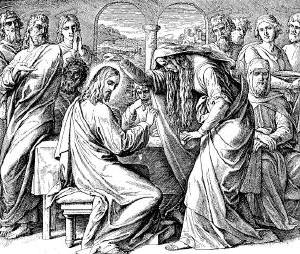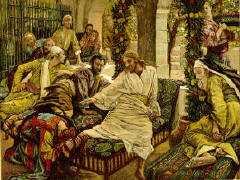Evangelism: Jesus Encounters a Sinful Woman
Luke 7:36-50
Key text: “When the Pharisee who had invited him saw this, he said to himself, ‘If this man were a prophet, he would know who is touching him and what kind of woman she is – that she is a sinner” (Luke 7:39).
Main point: Repentance involves understanding that we fall short of what God wants, and a desire to align our thoughts and actions with him. Forgiveness of sins is received by faith and is followed by gratitude and love toward the forgiver – Jesus Christ.
 Mary anoints Jesus Illustration by Julius Schnorr |
Introduction
The Gospel according to Luke emphasizes that Jesus came to save people who were lost (19:10). The passage before us (7:36-50) accentuates Jesus’ plan of salvation and the human conditions that accompany that plan. The good news is that everyone Jesus encounters, he desires to save from their sins, and his mission was more than sufficient to save all humanity. Nevertheless, not everyone accepts the salvation he brought. The encounter and dialog between Simon the Pharisee and Jesus concerning the sinful woman will shed light on why this is so.
The story of Simon the Pharisee as found in Luke should not be confused with similar stories found in the other Gospels. Simon was a common name in the time of Jesus, and the New Testament records the name at least a dozen times. Our story takes place in Simon’s home at mealtime. Jesus is an invited guest, and we are not sure why a Pharisee would make such an invitation, since for the most part they were at odds with Jesus’ teachings and ministry. Most likely, Simon was testing Jesus to find some fault or accusation against him. He did not have to wait long, for a woman of ill reputation, perhaps a prostitute, dared to enter the Pharisee’s home and make a scene over Jesus’ feet. And worst of all, Jesus did not push her away, but let her continue with her scandalous weeping and the drying with her own hair and kissing of Jesus’ feet! What was Simon to think of Jesus?
The crux of this story has to do with the contrast between the actions of two people. The contrast is between Simon the Pharisee and the sinful woman. The parable that Jesus gives to Simon illustrates the point that Jesus is making between the two. The story has to do with repentance and faith. Salvation may be given, but it will not be experienced as salvation unless it is received with faith, and faith is always accompanied by a change of thinking that we call repentance.
Apparently the sinful woman had previously heard the good news message from Jesus. She was full of sorrow for her many sins, and in faith she accepted Jesus as her Savior. As a result of having her enormous sinful debt cancelled, she poured herself out in loving gratitude over the One who had forgiven her. Simon does not see with spiritual eyes what God has done in this woman’s heart, so Jesus makes a public announcement that her many sins are forgiven. Her love for Jesus is so filled with gratitude that she cannot control her emotions.
In contrast, what does Simon the Pharisee show by his conduct? It is not that Simon has less need of Jesus, for we are all debtors who cannot pay. Jesus was his Savior, too, but Simon does not believe he needs Jesus, and confirms this by the absence of gratitude and love toward Jesus. Ironically, Simon was the more “religious” of the two!
Questions for Bible study
Read the following verses and respond to the questions:
1. Luke 7:36-39
a. What kind of invitation is Jesus given? Verse 36a. Who makes the invitation? Who are the Pharisees? Consult a Bible dictionary.
b. How does Jesus respond to the Pharisee’s invitation? Verse 36b. What does it mean to recline at the table? Is it the same as with our modern tables and chairs? Note: Custom at that time was to lie down on bedded sofas and recline on one arm while eating with the free hand. The table was very low to the floor, with the guests’ heads towards the table and their legs stretched out behind them as if lying down.
c. What kind of woman is described here? Verse 37a. Why does this woman dare to enter the Pharisee’s home? Do you think she already knows something of Jesus?
d. What does she bring with her? Verse 37b. Consult a Bible dictionary and describe the item in her possession.
e. Where is the woman positioned, and what is she doing? Verse 38a. How do Jesus’ feet get wet? Verse 38b. What does she do with her hair? Verse 38c. What two more things does she do to Jesus’ feet? Verse 38d. Why would a sinner do such things?
f. What does the Pharisee say to himself when he sees Jesus permitting this display to continue? Verse 39. According to the Pharisee, Jesus has failed the test of being a prophet. How does the Pharisee reason to that conclusion?
2. Luke 7:40-43
a. What does Jesus say to Simon the Pharisee? Verse 40a. What does Simon call Jesus? Verse 40b. Do you think that Simon has any idea that Jesus can read his thoughts?
b. Jesus presents a parable to Simon. What is it about? Verse 41. How do the two amounts compare to one another?
c. Does either debtor have the money to pay the debt back? Verse 42a. What action does the moneylender take? Verse 42b. What is the key question that the parable poses? Verse 42c.
d. What response does Simon give in answering the parable? Verse 43. How does Jesus judge Simon’s theoretical answer? Note: The Pharisees prided themselves in being ardent students of Scripture and masters in answering rabbinic parables and wisdom riddles.
3. Luke 7:44-50
a. Toward whom does Jesus turn, while at the same time he is addressing Simon? Verse 44a. What contrast does Jesus make between Simon’s actions and the woman’s? Verse 44b. Note: It was common courtesy in those days to offer water for cleaning the dust off the feet of a guest.
b. What second contrast does Jesus make between Simon’s actions and the woman’s? Verse 45. Note: It was also common courtesy for the host to welcome his guest with a kiss of friendship and well-being, as is still the case in many cultures.
c. What third contrast does Jesus make between Simon’s actions and the woman’s? Verse 46. Note: It was customary to anoint one’s guest with perfumed olive oil as a sign of honor.
d. What pronouncement does Jesus make concerning the sinful woman? Verse 47a. Does this mean that people are forgiven because of how much they are able to love (by works)? Or do people love much because they have come to realize the enormous debt already forgiven them (by faith)?
e. What about Simon’s condition? Verse 47b. Do you think that Simon has become aware that Jesus has read his thoughts?
f. What public pronouncement does Jesus make to the woman? Verse 48. If the woman’s sins were already forgiven in private, why does it have to be declared in public? How will this help the woman?
g. What do the other guests grumble about? Verse 49. What assurance does Jesus give to the woman? Verse 50.
 Mary anoints Jesus’ feet illustration by James Tissot |
Contemporary interaction:
1. What is the importance of repentance and faith as a response to the gospel? Define and explain both terms.
2. How easy is it for believers to fall into Simon’s kind of thinking? Can you explain how destructive a “holier than thou” attitude can be to a church’s evangelism program? What attitude should prevail among believers in regards to sinners?
Conclusion
Jesus’ encounter with a sinful woman teaches us the great price paid for the enormous debt of sin that we once carried. There are too many ungrateful Simons in the church. Let loving gratitude toward Jesus be characteristic of our walk with him.
Author: Lorenzo Arroyo
